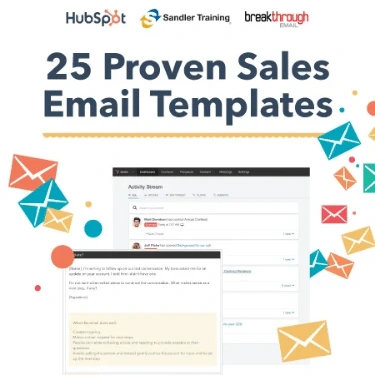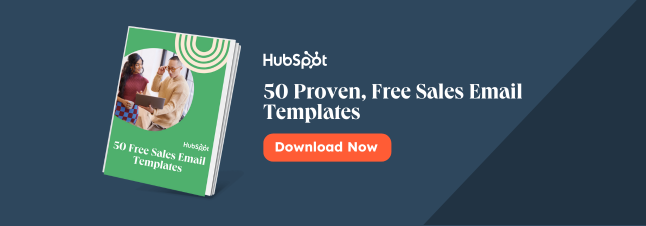I've seen a lot of cold emails as the managing editor of the HubSpot Sales Blog. Crafting outreach messages and getting high reply rates is challenging unless you know how to approach cold emailing.

Yet, the cold email is a powerful tool for salespeople to connect with potential clients. When executed correctly, it yields impressive results for your network and revenue.
To help you get there, I'll share my insights and best practices for compelling cold emails that grab attention and elicit those all-important positive responses.
Table of Contents
- What is cold emailing?
- Does cold emailing work?
- Cold Calling vs. Cold Emailing
- Cold Email Best Practices
- How to Write a Cold Email
What is cold emailing?
Cold emailing is a subset of email marketing where sales reps send unsolicited emails to prospects they have no prior connection to. I had my suspicions about its efficacy at first, but it’s a common practice for a reason. In fact, HubSpot’s State of Sales report reveals that 36% of sales professionals reach out to prospects using emails.

But just how effective is cold emailing?
Does cold emailing work?
From my observations, cold emailing works when done right. Compared to traditional advertising, cold emails allow for a highly targeted approach. By researching prospects and tailoring emails to their specific needs, salespeople can connect directly to the potential customers who will most benefit from products or services.
Research backs this up: 23% of sales pros say cold emailing is the best way to reach out to prospects. Furthermore, 21% of salespeople say sending cold emails to prospects results in the most leads.

Cold emailing is also relatively low-cost compared to other lead generation strategies. Reps don’t need expensive ad campaigns or elaborate marketing materials. They only have to research my contacts and personalize offers based on their interests.
I’ve learned that having the right mindset is key to crafting effective cold emails. When reaching out to a potential customer, savvy sales reps never look to close the deal as fast as possible. Instead, they entice prospects to reply with the three magic words all sales reps want to hear: “Tell me more.”
This approach helps reps build relationships with prospects and lays the foundation for a more meaningful connection in the future.

25 Free Sales Email Templates
Save time, find new ways to reach out to prospects, and send emails that actually convert.
- First-Touch Emails
- Follow-Up Emails
- Break-Up Emails
- Full Email Sequence
Download Free
All fields are required.

Cold Calling vs. Cold Emailing
Cold calling and cold emails have their place in the sales outreach arsenal. Each has different benefits depending on the situation.
Cold calls are generally more personal and dynamic. They allow reps to adjust to conversational elements like the prospect's tone and spontaneous questions. Calls are also harder to ignore than emails.
What about the drawbacks of cold calling? It’s easier to catch someone at a bad time or come off as intrusive, so you may run into prospects who are less receptive and polite in their responses.
In contrast, the main risk reps run with cold emailing is being ignored. It’s easy for a prospect to let an email sit unaddressed in their inbox — in that case, you should send a short follow-up email.
On the upside, with cold email campaigns, reps can automate the grunt work and track performance, which makes it generally more time-effective than making calls.
Ultimately, the decision of whether to leverage cold calls or cold emails depends on several factors, including:
- Timing. Use cold emails to reach prospects at their convenience. In contrast, use cold calls for immediate, real-time engagement.
- Content. Detailed information and attachments are better suited for cold emails, whereas cold calls are ideal for concise, interactive pitches.
- The prospect's professional level. High-level executives may prefer cold emails due to their busy schedules, while mid-level professionals might be more receptive to cold calls.
- Decision-making authority. Cold emails work well as an initial outreach to decision-makers who can review information for later. Cold calling is better for follow-up when people are already involved in the decision-making process.
- Buyer persona. Analytical and detail-oriented people may respond better to cold emails, whereas outgoing and collaborative people might prefer cold calls.
- The deal's momentum. Use cold emails to maintain a steady flow of updates. Leverage cold calling to address immediate concerns or push the deal forward quickly.
To learn this thoroughly, I recommend our guide on when to use cold calls versus sales emails.
Cold Email Best Practices
- Research the contact before reaching out.
- Stay away from anything generic.
- Follow up strategically.
- Respect the prospect’s privacy.
Before you even think about drafting a cold email, understand the do‘s and don’ts. I'll share four cold email best practices I always keep in mind to increase the chances of success.
Research the contact before reaching out.
A generic, one-size-fits-all email is always likely to end up in the trash. Before hitting send, take the time to understand your prospect’s business structure, trends in their industry, and potential needs. It shows that you respect their time and are genuinely interested in building a relationship.
So, how should you research? Always start with LinkedIn. Depending on the prospect, you can request a connection with them on that platform; it enhances the credibility of eventual cold email outreach and differentiates your communication from generic sales pitches.
You can also examine the prospect’s company website, especially their recent achievements. Use this info to create a highly personalized cold email. This will make your outreach efforts stand out, demonstrate that you understand their unique situation, and want to help them succeed further.
Stay away from anything generic.
Looking at my inbox right now, I can’t count the amount of emails devoid of personality, with generic phrases like “favored customer.” I’ll probably let them gather virtual dust forever.
Your cold emails will only stand out to your target audience if you prioritize personalization. Focus on why you’re contacting this specific person.
Maybe I’d have opened the email if the sender justified why they called me a “favored customer” compared to others — or if the email had said, "I read your email marketing post, and I’m a huge fan of your innovative approach to personalization strategies.”
Specify how you came across the lead. It’s a simple step, but it shows you didn’t just grab their contact information from a huge email list without any thought.
Follow up strategically.
It’s hard to admit, but sometimes you can send a good cold email content and get no response. In fact, most of the time, the first email goes unanswered. Therefore, always plan two or three thoughtful attempts — spaced out over several days or even weeks.
If you don’t get a response after that, move on. Sending too many messages just annoys people.
Stick to these etiquette rules when you send a follow-up email:
- Timing is key. Give the recipient enough time to read and consider your initial email without feeling rushed.
- Be professional. Acknowledge the recipient might be busy and that you don’t take it personally if they haven’t had a chance to respond.
- Add value. Throw in one more relevant article, insight, or offer that might interest the prospect.
- Keep it brief. Reiterate the main point of your initial email and express your continued interest in building a relationship.
Respect the prospect’s privacy.
While personalization is vital to cold emailing, avoid using so much personal information that it makes the recipient uncomfortable.
Imagine opening an email that reads, “Hi, I saw on your Facebook page that you’re back from a vacation to Hawaii. I bet you had a great time in the poolside suite. By the way, I wanted to reach out about ...”
It would definitely make me uneasy, so avoid delving into the person's family life or personal activities.
Instead, reference a professional accomplishment to show your genuine interest in their work. Here's an example:
“I found your recent article on LinkedIn about sustainable business practices very insightful. I wanted to reach out because ...”
The balance between personalization and privacy ensures my message is relevant and engaging without making the prospect uncomfortable.
How to Write a Cold Email
- Write your email with clear intention.
- Make it clear why you chose them.
- Touch on a relevant pain point.
- Use social proof and point to results.
- Keep it short, simple, and human.
- Perfect your subject line.
Let me cover some cold email tips that lead to consistent results for your outreach campaigns.
1. Write your email with clear intention.
I can only write a thoughtful, effective cold email if I know why I'm writing it in the first place. If I send an email just to introduce myself with no clear purpose or call to action (CTA), I'll likely end up with a confused (and presumably uninterested) recipient.
So, pick a purpose and write your email with it in mind. For example, do I want to set up a demo? Or do I want the recipient to put me in touch with someone with more decision-making authority? Or, maybe I just want 15 minutes of their time for a quick conversation to better understand their needs.
Remember that cold emails are a means to an end, and executing them effectively relies on knowing what that end is.
Pro tip: Check out our blog post on the best cold email templates; you’ll find ready-made examples you can customize to boost your conversion rates.
2. Make it clear why you chose them.
People like to feel important. Leverage this human desire in your outreach campaigns.
Always explain why you‘re reaching out to the recipient in particular. Highlight what drew you to them and why they’re important. This reminds them they have something to contribute, and it instills a sense of responsibility to take action.
For instance, if I want to invite someone to appear on my podcast, I’ll add a sentence or two about how their work would resonate with my audience and why.
My email body might read: “I love your articles on sustainable business practices, and I know my audience of eco-conscious entrepreneurs would, too. Your tips on reducing carbon footprints in small businesses are spot on and would be a massive hit with our listeners.”

25 Free Sales Email Templates
Save time, find new ways to reach out to prospects, and send emails that actually convert.
- First-Touch Emails
- Follow-Up Emails
- Break-Up Emails
- Full Email Sequence
Download Free
All fields are required.

3. Touch on a relevant pain point.
I don‘t want to receive a cold email that discusses an irrelevant straw man argument — a made-up issue that their product/service can solve but doesn’t apply to my situation.
That’s why I stressed the importance of doing your homework: Understand your prospect's needs, circumstances, industry, business structure, and other key factors that shape their need for your solution. We can easily turn that into some pain points.
Quintin Redmond, a publisher development director at Aditude, uses tools like SimilarWeb to analyze his target audience and assess how his value proposition can enhance the prospect’s business.

You can draw similarities between the recipient and existing customers you have. From there, you can extrapolate real issues they're most likely running into. Those will be the focal point of your email.
4. Use social proof and point to results.
Always point to prospects' industry peers and mutual connections that saw results with your solution. Having a trusted source vouch for me typically gives my cold emails the extra oomph they need to get a reply.
Another impactful social proof is case studies that show the tangible benefits of your product or service. In my experience, they’re much better than generic testimonials.
Colton Agar, head of marketing at Red Stag Fulfillment, also applies this concept to his cold emails. “My strategy is to show — rather than tell — my prospects how I do things differently. To do so, I insert a summary of a successful case study of previous (or existing) clients and a link to my resources page so they can read the full story,” he says.

5. Keep it short, simple, and human.
Always strive to keep cold emailing formal but conversational. Overly professional outreach can come across as inauthentic, AI-generated copy, which kills any hope the recipient will entertain my offer. To avoid that, I usually read my emails out loud to ensure they don't sound choppy or awkward.
In addition, I aim to keep my copy concise since no one wants to read a full essay with every feature and benefit my product/service has to offer.
6. Perfect your subject line.
I've received many emails with generic subject lines like “The best solution for all your marketing needs.” This makes it clear the sender didn’t take the time to understand the very specific issues I’m trying to solve in my particular role and industry niche.
Prospects want solutions that directly suit their needs, so the cold email subject lines you use must reflect that level of targeted specificity.
Getting this right is important, as 64% of people decide to open or delete emails based on how they perceive your subject line. More specifically, 33% of people will open your email if the subject line is catchy.

To make the catchiest subject line, boil down what you want to say into five to seven words. Then, write a few options and then evaluate which subject line you would most likely click on.
A good technique is mentioning specific details related to the recipient, which attracts their attention. For example, if I learn that a prospect is involved in launching a new tech startup, I'll mention this context directly in my subject header: “Excited about your new tech venture, [Name]!”
Experiment with unconventional approaches, like a thought-provoking question or a sneak peek into my email's value. You can speak to your recipient’s interests while communicating what you want from connecting with them.
Pro tip: Use HubSpot’s Free AI Content Writer to generate engaging cold email subject lines that increase your open rate.
Write Cold Emails That Get Responses
Throughout this post, I've shared the strategies that help reps achieve high response rates with cold emailing — from perfecting subject lines to researching prospects.
I‘ve learned that the best cold emails require time, research, and personalization. If you implement these tips into your broader cold emailing strategy, you’ll see more positive replies.
![Download Now: 25 Sales Email Templates [Free Access]](https://no-cache.hubspot.com/cta/default/53/be67aa79-8dbe-4938-8256-fdf195247a9c.png)




![What Is Cross-Selling? Intro, Steps, and Pro Tips [+Data]](https://knowledge.hubspot.com/hubfs/ft-cross-selling.webp)


![22 Best Sales Strategies, Plans, & Initiatives for Success [Templates]](https://www.hubspot.com/hubfs/Best-Sales-Strategies-1.png)

![7 Social Selling Trends to Leverage This Year [New Data]](https://www.hubspot.com/hubfs/social%20selling%20trends.png)
![How Do Buyers Prefer to Interact With Sales Reps? [New Data]](https://www.hubspot.com/hubfs/person%20phone%20or%20online%20sales%20FI.png)